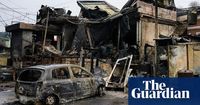A massive wildfire that swept through large swaths of South Korea’s North and South Gyeongsang provinces has finally been fully contained after a harrowing 10 days, authorities confirmed on Sunday, March 30, 2025. The fires, which first ignited on March 21, devastated approximately 48,000 hectares of woodland—an area roughly equivalent to 80% of the size of Seoul—marking this as the worst wildfire disaster in South Korea's history.
According to the Korea Forest Service, the wildfire was initially reported to be under control by Friday, March 28, 2025. However, it reignited overnight on Saturday, March 29, prompting ongoing firefighting efforts. The situation was exacerbated by gusty winds and dry conditions, which allowed the flames to spread rapidly across the landscape.
Tragically, the wildfires have claimed at least 30 lives, including a helicopter pilot who died when his aircraft crashed while attempting to combat the blaze in a mountainous area. In addition to the loss of life, the inferno has destroyed around 4,000 structures, including the historic Gounsa Temple, a UNESCO World Heritage Site that dates back over 1,300 years, along with numerous homes and factories.
The police have arrested a 56-year-old man suspected of inadvertently igniting the fire while performing an ancestral rite at his family grave in Uiseong County, North Gyeongsang province. This individual reportedly attempted to burn tree branches that were overhanging the graves with a cigarette lighter, which led to the flames spreading uncontrollably.
According to reports, the suspect's daughter informed investigators that her father was trying to clear the area when the fire flared up, carried by the wind. Despite the gravity of the situation, the suspect has denied any involvement in the fire's ignition. The police have booked him without detention as they conduct a thorough investigation, which will involve collaboration with the National Institute of Forest Science, the National Forensic Service, and fire authorities.
The South Korean police have stated that they plan to summon the suspect for questioning once the on-site inspection is complete, a process that could take over a month. The investigation aims to determine the exact circumstances that led to this catastrophic event.
As the fires raged, the region faced not only environmental destruction but also highlighted broader societal issues, such as South Korea’s demographic crisis and regional disparities. Rural areas, like those affected by the fire, are often underpopulated and have a disproportionately elderly population, raising concerns about the resilience of these communities in the face of such disasters.
Officials have pointed to the ongoing climate crisis as a contributing factor to the severity of the wildfires. The area has experienced below-average rainfall for months, compounded by the fact that 2024 was recorded as South Korea’s hottest year. The combination of high temperatures and dry conditions has created a perfect storm for wildfires, leaving many to question how climate change is influencing the frequency and intensity of such disasters.
As the country begins to assess the damage and work toward recovery, the focus will also be on future preventive measures. Experts emphasize the need for improved forest management and fire prevention strategies to mitigate the risks posed by wildfires in the future.
The aftermath of this disaster will likely prompt discussions on emergency preparedness and response strategies, particularly in rural areas that may be ill-equipped to handle such large-scale emergencies. The loss of life and property has left a deep scar on the communities affected, and healing will take time.
In the coming weeks, as investigations continue and recovery efforts ramp up, the people of North and South Gyeongsang provinces will need support from both local and national governments. The hope is that lessons learned from this tragedy will lead to better preparedness and resilience against future wildfires.




